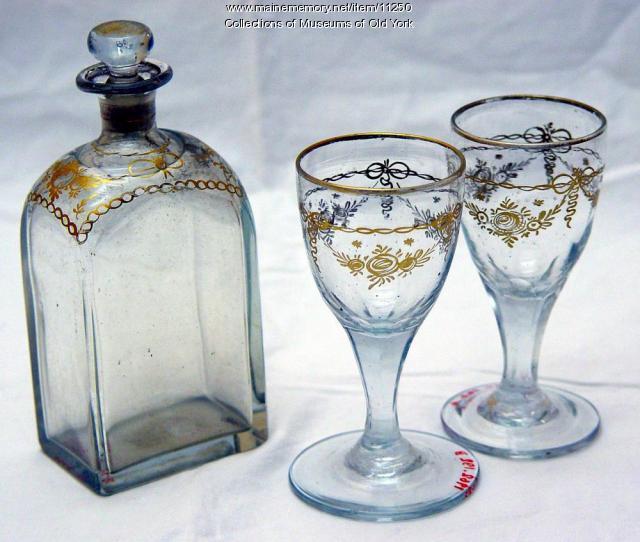Keywords: New York
Item 36414
Sally (Sayward) Barrell, York, 1868
Contributed by: Old York Historical Society Date: 1868 Location: York Media: Oil on canvas
Item 11242
Walnut high chest, attributed to John Bradbury, Sr., York, ca. 1740
Contributed by: Old York Historical Society Date: circa 1740 Location: York Media: Walnut with pine secondary
Item 87300
Assessor's Record, 30-38 York Street, Portland, 1924
Owner in 1924: New England Cold Storage Company Use: Storage
Item 37293
121-125 Commercial Street, Portland, 1924
Owner in 1924: John J Devine Use: Store & Storage
Item 111769
New York Specialty Co., Portland, ca. 1900
Contributed by: Maine Historical Society Date: circa 1900 Location: Portland Client: New York Specialty Co. Architect: John Calvin Stevens; New York Specialty Co.
Item 110148
Middle Dutch Church, Lafayette (now Astor) Place, New York, New York City, NY, 1837
Contributed by: Maine Historical Society Date: 1837 Location: New York City; New York City Client: Middle Dutch Church Architect: Isaiah Rogers
Exhibit
Immigration is one of the most debated topics in Maine. Controversy aside, immigration is also America's oldest tradition, and along with religious tolerance, what our nation was built upon. Since the first people--the Wabanaki--permitted Europeans to settle in the land now known as Maine, we have been a state of immigrants.
Exhibit
Toy Len Goon: Mother of the Year
Toy Len Goon of Portland, an immigrant from China, was a widow with six children when she was selected in 1952 as America's Mother of the Year.
Site Page
View collections, facts, and contact information for this Contributing Partner.
Site Page
"… in Biddeford and Saco: the Saco-Lowell Shops, York (Bates) Manufacturing, and Pepperell (WestPoint) Manufacturing, would follow a similar pattern."
Story
Minik Wallace 1891-1918
by Genevieve LeMoine, The Peary-MacMillan Arctic Museum
The life of Minik, an Inuit person from Greenland who grew up in New York City.
Story
One of the first abstract painters in Maine
by William Manning
I have grown as a painter in ways I might not have if I moved to New York
Lesson Plan
Maine Statehood and the Missouri Compromise
Grade Level: 9-12
Content Area: Social Studies
Using primary sources, students will explore the arguments for and against Maine statehood and the Missouri Compromise, and the far-reaching implications of Maine statehood and the Missouri Compromise such as the preservation and spread of slavery in the United States. Students will gather evidence and arguments to debate the statement: The Missouri Compromise was deeply flawed and ultimately did more harm to the Union than good.
Lesson Plan
Grade Level: 9-12
Content Area: English Language Arts, Social Studies
Most if not all of us have or will need to work in the American marketplace for at least six decades of our lives. There's a saying that I remember a superintendent telling a group of graduating high-school seniors: remember, when you are on your deathbed, you will not be saying that you wish you had spent more time "at the office." But Americans do spend a lot more time working each year than nearly any other people on the planet. By the end of our careers, many of us will have spent more time with our co-workers than with our families.
Already in the 21st century, much has been written about the "Wal-Martization" of the American workplace, about how, despite rocketing profits, corporations such as Wal-Mart overwork and underpay their employees, how workers' wages have remained stagnant since the 1970s, while the costs of college education and health insurance have risen out of reach for many citizens. It's become a cliché to say that the gap between the "haves" and the "have nots" is widening to an alarming degree. In his book Wealth and Democracy, Kevin Phillips says we are dangerously close to becoming a plutocracy in which one dollar equals one vote.
Such clashes between employers and employees, and between our rhetoric of equality of opportunity and the reality of our working lives, are not new in America. With the onset of the industrial revolution in the first half of the nineteenth century, many workers were displaced from their traditional means of employment, as the country shifted from a farm-based, agrarian economy toward an urban, manufacturing-centered one. In cities such as New York, groups of "workingmen" (early manifestations of unions) protested, sometimes violently, unsatisfactory labor conditions. Labor unions remain a controversial political presence in America today.
Longfellow and Whitman both wrote with sympathy about the American worker, although their respective portraits are strikingly different, and worth juxtaposing. Longfellow's poem "The Village Blacksmith" is one of his most famous and beloved visions: in this poem, one blacksmith epitomizes characteristics and values which many of Longfellow's readers, then and now, revere as "American" traits. Whitman's canto (a section of a long poem) 15 from "Song of Myself," however, presents many different "identities" of the American worker, representing the entire social spectrum, from the crew of a fish smack to the president (I must add that Whitman's entire "Song of Myself" is actually 52 cantos in length).
I do not pretend to offer these single texts as all-encompassing of the respective poets' ideas about workers, but these poems offer a starting place for comparison and contrast. We know that Longfellow was the most popular American poet of the nineteenth century, just as we know that Whitman came to be one of the most controversial. Read more widely in the work of both poets and decide for yourselves which poet speaks to you more meaningfully and why.





















